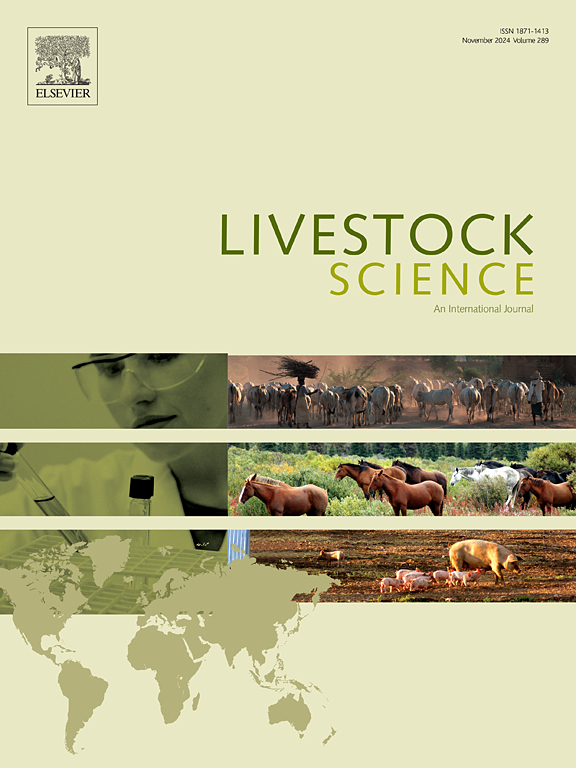Influence of different levels of black soldier fly larvae meal on growth performance and carcass quality of broiler chickens
IF 1.8
3区 农林科学
Q2 AGRICULTURE, DAIRY & ANIMAL SCIENCE
引用次数: 0
Abstract
A study was conducted to examine the impact of two inclusion levels of Black soldier fly larvae meal (BSFLM) replacing soybean meal on growth performance, nutrient utilization, carcass characteristics and meat quality of broilers. Three experimental diets based on corn-soybean meal were developed to contain 0 (control), 6 (BSF 6) and 12% (BSF 12) BSFLMfor both starter and grower phases. Each experimental diet was randomly allotted to six replicate pens (eight birds per pen). The birds were offered starter pellets from 0 to 14 day post-hatch and grower pellets from 15 to 28 day post-hatch. The experimental diets were tested for pellet durability index (PDI). There was an interaction between diet and growth phase (P < 0.001) for pellet durability index where starter diets had always a higher PDI than the grower diets, but the difference was greater for control diet than BSF 6 and BSF 12 diets. Apparent metabolizable energy (AME) of diets and coefficients of apparent ileal digestibility (CAID) of nutrients were measured on day 28 using titanium dioxide marker ratios in the diet and excreta/ileal digesta. On day 28, the weights of live body, carcass, fat pad, breast and gizzard were recorded, and then breast meat quality (meat pH, drip loss and cooking loss) was examined. Inclusion of BSFLM of up to 12 % did not reduce live weight gain or feed intake. Live weight and carcass weight were heavier in broilers fed 12 % BSFLM than controls (P < 0.02), but were not different than those fed 6 %, while controls were not different than those fed 6 %. Breast weight (percentage live weight) was lower in birds offered 12 % BSFL than in others (P < 0.04). No differences were observed between diets for the percentage weight as carcass, fat, pad and gizzard. The AME and AMEc of diets were the highest in broilers fed 6 % BSFLM diet (P < 0.005), but there were no differences between controls and those fed 12 % BSFLM. The CAID of DM, ash and N in birds fed 6 % BSFLM were greater than (P < 0.03) birds fed 12 %, but were not different than controls, which were also not different than those fed 12 %. Broiler breast meat quality was unaffected by dietary treatments. In conclusion, BSFLM at 12 % can be used effectively as a SBM replacement in starter and grower diets, without affecting the growth performance, nutrient utilization, carcass characteristics and meat quality of broiler chickens.
不同水平的黑翅蝇幼虫粉对肉鸡生长性能和胴体质量的影响
本研究考察了两种水平的黑翅蝇幼虫粉(BSFLM)替代豆粕对肉鸡生长性能、营养利用率、胴体特征和肉质的影响。以玉米-豆粕为基础配制了三种实验日粮,分别含有 0(对照组)、6(BSF 6)和 12%(BSF 12)的 BSFLM,用于初生期和生长期。每种实验日粮随机分配到六个重复的圈舍(每个圈舍八只鸡)。孵化后 0 天至 14 天为初生期颗粒饲料,孵化后 15 天至 28 天为生长期颗粒饲料。对实验日粮进行了颗粒耐用指数(PDI)测试。日粮和生长阶段对颗粒耐久指数有交互作用(P <0.001),初生日粮的颗粒耐久指数总是高于生长日粮,但对照日粮的差异大于 BSF 6 和 BSF 12 日粮。第 28 天,利用日粮和排泄物/回肠消化物中的二氧化钛标记物比率测量日粮的表观代谢能(AME)和营养物质的表观回肠消化系数(CAID)。第 28 天,记录活体、胴体、脂肪垫、胸脯肉和胗的重量,然后检测胸脯肉的质量(肉 pH 值、滴水损失和蒸煮损失)。添加高达 12% 的 BSFLM 不会降低活体增重或饲料摄入量。饲喂 12 % BSFLM 的肉鸡的活重和胴体重都比对照组重(P < 0.02),但与饲喂 6 % BSFLM 的肉鸡相比没有差异,而对照组与饲喂 6 % BSFLM 的肉鸡相比没有差异。饲喂 12 % BSFL 的家禽的胸重(活重百分比)低于其他家禽(P < 0.04)。不同日粮的胴体、脂肪、脂肪垫和胗的百分比重量没有差异。饲喂 6 % BSFLM 日粮的肉鸡的日粮 AME 和 AMEc 最高(P < 0.005),但对照组和饲喂 12 % BSFLM 的肉鸡之间没有差异。饲喂 6 % BSFLM 日粮的肉鸡的 DM、灰分和 N 的 CAID 均高于饲喂 12 % BSFLM 日粮的肉鸡(P < 0.03),但与对照组相比没有差异,而对照组与饲喂 12 % BSFLM 日粮的肉鸡相比也没有差异。肉鸡胸脯肉的品质不受日粮处理的影响。总之,12 % 的 BSFLM 可以有效地用作初生鸡和生长鸡日粮中的 SBM 替代品,而不会影响肉鸡的生长性能、营养利用率、胴体特征和肉质。
本文章由计算机程序翻译,如有差异,请以英文原文为准。
求助全文
约1分钟内获得全文
求助全文
来源期刊

Livestock Science
农林科学-奶制品与动物科学
CiteScore
4.30
自引率
5.60%
发文量
237
审稿时长
3 months
期刊介绍:
Livestock Science promotes the sound development of the livestock sector by publishing original, peer-reviewed research and review articles covering all aspects of this broad field. The journal welcomes submissions on the avant-garde areas of animal genetics, breeding, growth, reproduction, nutrition, physiology, and behaviour in addition to genetic resources, welfare, ethics, health, management and production systems. The high-quality content of this journal reflects the truly international nature of this broad area of research.
 求助内容:
求助内容: 应助结果提醒方式:
应助结果提醒方式:


